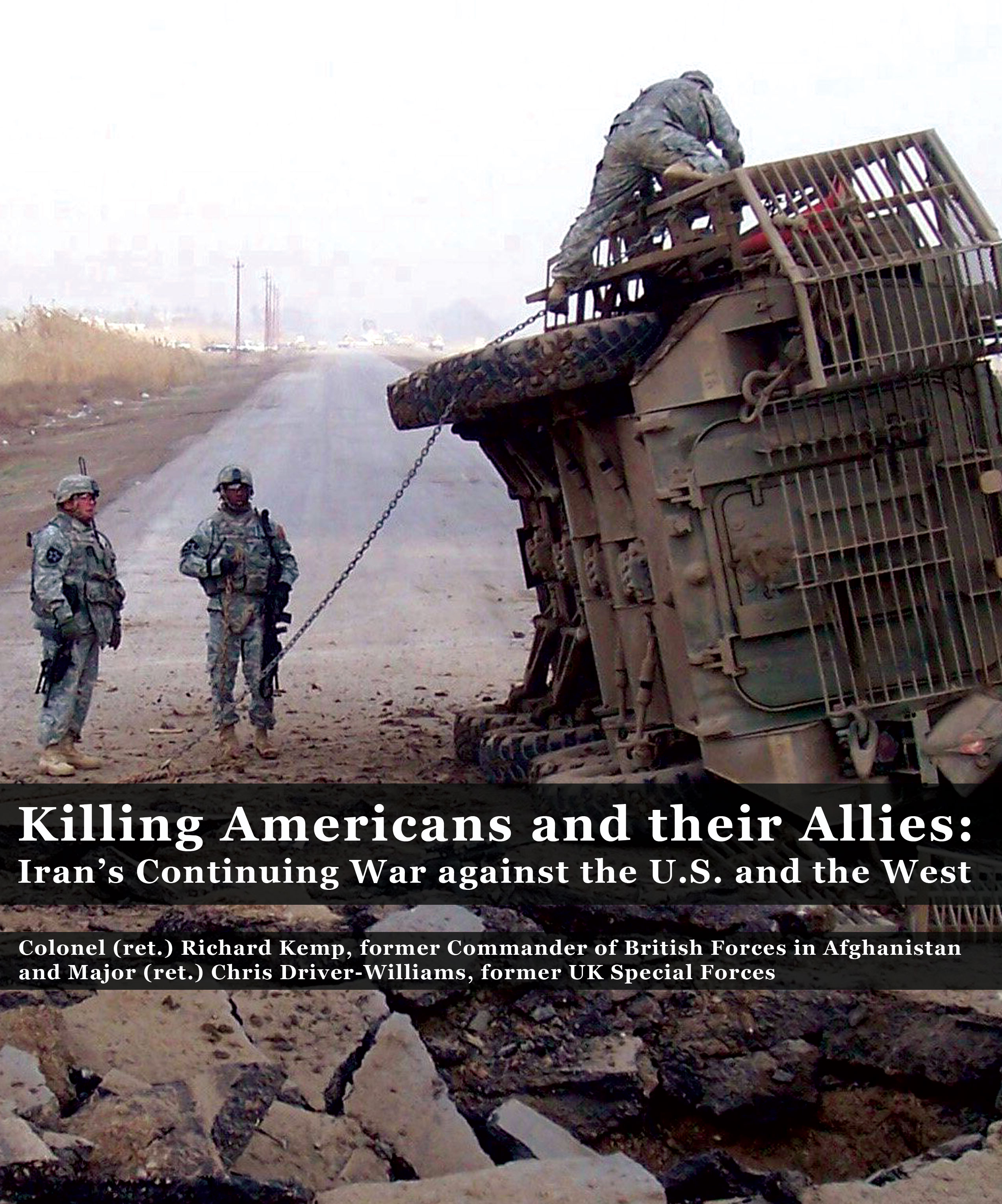
Preface
Executive Summary
Introduction
The Islamic Revolutionary Guard Corps
Lebanese Hizbullah
Killing U.S. and Allied Troops in Iraq
Killing U.S. and Allied Troops in Afghanistan
Killing Americans and Allies Globally
Killing America’s Israeli Allies
Annex A – Hizbullah: Historic Killing
-->
Killing Americans and their Allies: Iran’s Continuing War against the United States and the WestBy Colonel (ret.) Richard Kemp and Major (ret.) Chris Driver-Williams
March 2015
Iranian-supplied weapons have led to casualties across the Western alliance for Britain, Israel, and the United States. Tehran has used its weapons deliveries to fuel a number of regional insurgencies, like the Houthi revolt in Yemen.
Iran’s Revolutionary Guard Corps and its Hizbullah proxy serve as expeditionary forces for Iran throughout the Middle East, with the latter coordinating terror attacks and fundraising activities in Latin America, Africa and Asia.
State-of-the-art roadside bombs — Explosively Formed Penetrators (EFPs) — from Iran in particular were undoubtedly the most lethal Iranian weapon used against British and American forces in Iraq and Afghanistan. Thus the analysis that follows by two former British officers is of extreme importance to anyone concerned with halting the destabilization of the Middle East and the future security of the region.
– Amb. Dore Gold
Executive Summary
- Iranian military action, often working through proxies using terrorist tactics, has led to the deaths of well over a thousand American soldiers in Iraq and Afghanistan over the last decade and a half.
- Throughout the course of the Iraq campaign, a variety of weapons flowed into the country through direct purchases by the government of Iran. These included Explosively Formed Penetrators (EFPs), a shaped charge designed to penetrate armor. These weapons – often camouflaged as rocks – were identical to those employed by Hizbullah against Israeli forces. In 2006, the British Telegraph revealed that three Iranian factories were “mass producing” the roadside EFP bombs used to kill soldiers in Iraq.
- In 2007, American troops discovered over 100 Austrian-made Steyr HS50 .50 caliber sniper rifles in Iraq. These high-powered rifles, which fire Iranian bullets, can pierce all in-service body armor from up to a mile and penetrate U.S. armored Humvee troop carriers. The rifles were part of a larger shipment legally purchased from the Austrian manufacturer under the justification that they would be used by Iranian police to combat drug smugglers.
- Iran paid Taliban fighters $1,000 for each U.S. soldier they killed in Afghanistan. The Sunday Times reported that a Taliban operative received $18,000 from an Iranian firm in Kabul as reward for an attack in 2010 that killed several Afghan government troops and destroyed an American armored vehicle.
- Iranian President Rouhani’s so-called “moderation” was displayed when he appointed Brig.-Gen. Hossein Dehghan to be minister of defense. Dehghan played a key role in the October 1983 suicide bomb attacks in Beirut in which 241 U.S. Marines and 58 French paratroopers were killed. Meanwhile, inside Iran, Rouhani has presided over a rise in repression, including executions, torture of political prisoners, and persecution of minorities.
Introduction
It appears that the recent framework agreement between the Islamic Republic of Iran and the P5+1, led by the U.S. Administration, will result in a deal that would allow Iran to become a nuclear-armed state. In this context, it is worth recalling the true nature of the Islamic Republic, in particular its recent track-record of violence against the United States and its allies. Both authors of this study had responsibilities for UK national intelligence assessment and crisis management during the period when this violence reached its peak in Iraq.
Many have forgotten, or perhaps never realized, that Iranian military action, often working through proxies, usually using terrorist tactics, has led to the deaths of well over a thousand American soldiers in Iraq and Afghanistan over the last decade and a half. Does it make sense to risk allowing a regime that, since its inception, has been conducting a war against the United States and its allies to become a nuclear power?
Anti-Americanism helped fuel the 1979 Islamic revolution in Iran. A violent anti-American doctrine that challenges any role for America in the Middle East, has been and remains the central focus of Iranian foreign policy. Since the revolution, Iran has waged and continues to wage war against the United States and its allies.
Iran has conducted this war primarily using the Islamic Revolutionary Guard Corps Qods Force (IRGC-QF) and the Iranian proxy Lebanese Hizbullah. Both have been engaged in direct military action; and both have cultivated and supported military action abroad by other proxies, mainly through the use of terrorist bombings, abductions and assassinations. The killing of U.S. soldiers in Iraq and Afghanistan serves a strategic goal (see later section “Killing Americans and Allies Globally”). However, Iranian violence has often been intended not to achieve any specific tactical or strategic objective, but simply to hurt the U.S. Most of these actions have been designed to be deniable, or at least unprovable.
Focusing primarily on events since 2001, this study will survey Iran’s war against the U.S. and its allies, using organs of the Iranian government as well as proxies.
The majority of Tehran’s killing of Americans was done in Iraq up until the U.S. withdrawal in 2011. Some occurred in Afghanistan until more recently, and likely continues today against America’s Afghan allies, and may again occur against U.S. forces that remain there. The current curtailment of this activity has not been due to a change of stance by Iran, but to the redeployment of U.S. and allied forces. Depending on future U.S. action in Iraq and Syria, it is quite likely that Iran will again orchestrate attacks against American troops, even as they are fighting the same enemy (the Islamic State).
Those who have seized upon President Hassan Rouhani as a “moderate” with whom business can be done by the West should exercise caution. He was “elected” president because that was the will of the Supreme Leader, Ali Hosseini Khamanei. The Supreme Leader controls the president and is head of the armed forces, responsible for national defense.
An indication of Rouhani’s “moderation,” and his own stance towards the U.S., occurred early on when he appointed Brigadier General Hossein Dehghan to be minister of defense. Dehghan played a key role in the October 1983 suicide bomb attacks in Beirut in which 241 U.S. Marines and 58 French paratroopers were killed.
Meanwhile, inside Iran, Rouhani has presided over a rise in repression, including executions, torture of political prisoners and persecution of minorities, according to an analysis published by human rights groups including Amnesty International.
1
Islamic Revolutionary Guard Corps (IRGC)
Founded by Ayatollah Khomeini shortly after the overthrow of the Shah and the onset of the Islamic Revolution in 1978-1979, Iran’s IRGC has morphed from its initial, mainly ideological composition into a particularly powerful organ of Iran’s political system, the upper echelons of which tend to be drawn from the ranks of the IRGC. On September 2, 2007, for instance, Khamenei named Mohammad Ali Jafari as commander in chief of the IRGC. Along with other regime hardliners, Jafari has continued to oppose serious concessions in the context of a permanent nuclear agreement with the West.
The IRGC is comprised of an army, navy and air force. Iran frequently performs naval exercises in the Gulf as a show of strength and continues to develop “anti-access and area denial” capabilities to control the Strait of Hormuz and its approaches. More specifically, the IRGC is developing increasingly lethal systems such as:
- Advanced naval mines.
- Coastal defense and anti-ship cruise and ballistic missiles.
- Attack craft.2
Additionally, the IRGC boasts a paramilitary unit, comprised of approximately 10-20,000 individuals, known as the Qods Force. The strategic objective of IRGC-QF is to subvert Iran’s enemies and export the Iranian Revolution, a goal it attains largely by facilitating the delivery of weapons to pro-Iranian factions in Lebanon, Iraq, Syria, Persian Gulf states, Gaza and the West Bank, Afghanistan and Central Asia.
3 In 2007, the Treasury Department designated IRGC-QF as a terrorism-supporting entity.
From 1988-1995, the commander of IRGC-QF was Brigadier General Ahmad Vahidi, who subsequently served as defense minister in 2009-2013. He led IRGC-QF when it allegedly facilitated two terrorist bombings of Israeli and Jewish targets in Buenos Aires, killing more than 100 people and wounding 540. Moreover, he allegedly recruited Hizbullah activists later accused of the June 1996 Khobar Towers bombing in which 19 U.S. servicemen lost their lives and 498 were wounded. He also orchestrated the assassination of Iranian dissident leaders in Europe in the early 1990s.
Since 1998, Major General Qassem Suleimani has led IRGC-QF, in which time he has created branches focused on intelligence, finance, politics, sabotage and special operations. With a direct and independent channel to Khamenei, Suleimani has successfully sought the assassination of political rivals, armed terrorist proxies and directed a network of insurgent groups in Iraq that killed over a thousand Americans.
In 2010, IRGC-QF and Hizbullah reportedly launched a new campaign against American and Israeli targets. The move was designed in apparent retaliation for the covert effort to deter the Iranian nuclear program, including the implementation of the Stuxnet virus and the death and disappearance of some prominent Iranian nuclear scientists.
4 In the last five years, Suleimani has planned and directed attacks in Thailand, New Delhi, Lagos, Nairobi, and even the United States. The latter involved the dispatch of two Iranian agents to assassinate the Saudi Ambassador to the U.S. by bombing a restaurant a few miles from the White House.
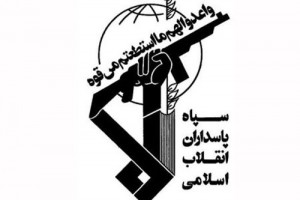
Islamic Revolutionary Guard Corps Logo
Lebanese Hizbullah
Hizbullah was formed in 1982 as the terrorist arm of the Islamic regime in Tehran. Ali Akbar Mohtashemi, Iran’s then-ambassador to Syria, helped create Hizbullah, a Lebanese-based Shiite Muslim terrorist organization. The group’s original goal was to establish an Islamic republic in Lebanon. The radical brand of Islam that Iran’s spiritual leader Ayatollah Ruhollah Khomeini espoused during his reign served as the inspiration for Hizbullah. The platform of Hizbullah pledges loyalty to Iran’s Supreme Leader and urges the establishment of an Islamic regime and the destruction of Israel.
5
Iran has helped Hizbullah build a global terror network and a substantial military framework that is unparalleled in any other terrorist group in the world. Iran frequently supports Hizbullah terror operations, often employing agents from the IRGC who operate clandestinely from Iranian embassies worldwide. It directs Hizbullah and provides it with personnel, terrorist training, intelligence, logistics and finances; and has supplied large quantities of high-grade weapons, including:
- Advanced anti-tank missiles. Hizbullah’s anti-tank guided missiles include the Russian-made AT-3 Sagger, AT-4 Spigot, AT-5 Spandrel, AT-13 Saxhorn-2 ‘Metis-M’, АТ-14 Spriggan ‘Kornet’, Iranian-made Ra’ad (version of AT-3 Sagger), Towsan (version of AT-5 Spandrel), Toophan (version of BGM-71 TOW), and European-made MILAN missiles.
- Katyusha [Grad] rockets. Hizbullah possesses the Katyusha-122 rocket, which has a range of 29 km (18 miles) and carries a 15-kg. (33-lb.) warhead.
- Artillery cannons.
- Anti-aircraft weapons including the ZU-23 artillery and the man-portable, shoulder-fired SA-7 and SA-18 surface-to-air missile (MANPADS).
- Naval warfare materiel, including the C-802 anti-ship missile.
- Unmanned aerial vehicles (UAVs). Iran has supplied Hizbullah with Mohajer-4 UAVs. These were reportedly flown successfully into Israeli airspace in November 2004 and April 2005. A Hizbullah drone was shot down off the coast of northern Israel in April 2013.
- Ground-to-ground long-range rockets. Hizbullah’s long-range missiles include the Iranian-made Fajr-3 and Fajr-5, the latter with a range of 75 km. (47 miles), enabling it to strike the Israeli port of Haifa; and the Zelzal-1, with an estimated 150 km (93 miles) range, which can reach Tel Aviv. Fajr-3 missiles have a range of 40 km (25 miles) and a 45-kg. (99-lb.) warhead, and Fajr-5 missiles also carry 45-kg. (99-lb.) warheads. In 2014 various news accounts reported Hizbullah had acquired heavy Scud missiles.
No terrorist organization in the world benefits from such significant, ongoing and regular supply of high-grade, sophisticated munitions.
As well as munitions, Iran provides approximately $100-200 million per year in funding to support Hizbullah.
6,7 Hizbullah’s operational infrastructure was developed almost entirely with extensive Iranian backing including financial support, transportation of weapons and training of the organization’s activists. Hizbullah is seen as an Iranian forward unit in Lebanon and the ultimate product of the Islamic Revolution.
In an interview he gave to the Iranian newspaper
Al-Sharq, Ali Akbar Mohtashemi (one of Khomeini’s loyalists, a founder of Hizbullah, former Iranian ambassador to Syria and Lebanon and former Iranian Minister of Interior) addressed the relationship between Hizbullah and Iran. He stated that “Hizbullah is part of the Iranian rulership; Hizbullah is a central component of the Iranian military and security establishment; the ties between Iran and Hizbullah are far greater than those between a revolutionary regime
with a revolutionary party or organization outside its borders.”
8
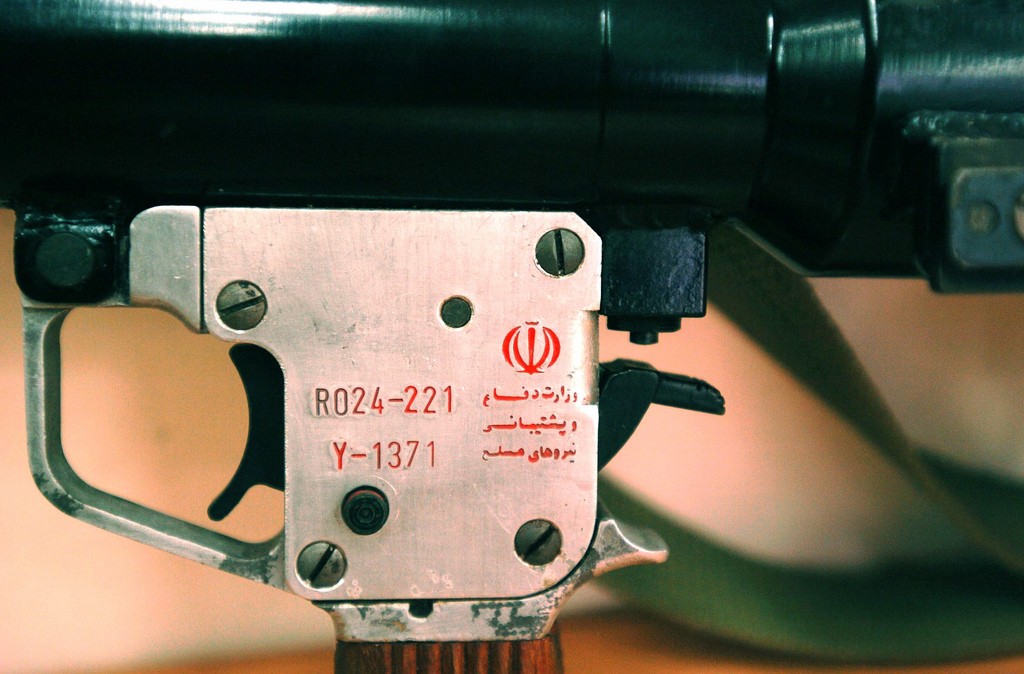
Iranian army RPG used by Hizbullah in Lebanon
Hizbullah’s Shura Council makes strategic decisions regarding the organization’s terrorist activities locally, regionally and abroad, as well as all decisions concerning socio-political policy in the Lebanese, regional and international systems. It is comprised of nine permanent members, two of whom are always Iranian government or military officials.
Hizbullah continually demonstrates a deep and profound animosity towards the U.S. A central facet of the organization’s ideology, that enmity is a direct result of the Iranian revolutionary outlook that defined the U.S. as the “Great Satan.” Hizbullah claims that the goal of American policy is to take control over the entire region and to strip the Arabs of their natural resources, with Israel being a means of achieving this plan.
Since the U.S. began its campaign against international terrorism following 9/11, Hizbullah has significantly increased its level of rhetoric, incitement and propaganda against the U.S. and its policies. Additional motivation came from the U.S. presence in Iraq, the Iranian nuclear program crisis and Israel’s Second Lebanon War in July and August 2006. Indeed, the Second Lebanon War was perceived by Hizbullah leader Hassan Nasrallah as an additional phase in the American conspiracy intended to dominate the Middle East and usurp its resources. Hizbullah views Israel as a proxy for America to attain its objectives in Lebanon. The chants of “death to America” and “death to Israel” are often heard during Hizbullah ceremonies and rallies in Lebanon, in Iran and amongst the organization’s supporters around the world.
Many significant Hizbullah operations against the U.S. and its allies since 2001 are described below, along with the activities of other limbs and proxies of the Iranian regime. Historic Hizbullah attacks are outlined at Annex A.
Killing U.S. and Allied Troops in Iraq
Iran viewed the conflict in Iraq that began in 2003 as a part of its war with the United States and its Middle East allies. During the conflict, Iran supplied weapons, ammunition and other munitions to many of the extremist groups, both Sunni and Shia, which were attacking U.S. and Coalition forces. Iran also sent IRGC and Hizbullah officials to train, guide, direct and motivate those groups.
9 Iran-backed Shiite militias used sophisticated weapons, including lethal armor-piercing versions of IEDs and rocket-boosted mortars, according to Adm. Mike Mullen, then Chairman of the U.S. Joint Chiefs of Staff.
10
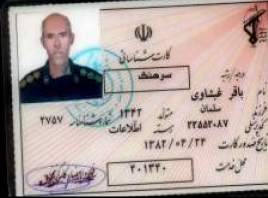
ID card identifying an individual as an IRGC officer, recovered during a 2007 raid on the Irbil IRGC office in Iraq. The IRGC insignia is in the top right of the card. Hizbullah members worked closely with clandestine members of the IRGC in Iraq.
Iran’s support for Iraqi insurgents led to the deaths of an estimated 1,100 U.S. soldiers as well as other Coalition troops in Iraq, including British forces. Former U.S. ambassador to Iraq from 2010-2012, James Jeffery, said: “Up to a quarter of the American casualties and some of the more horrific incidents in which Americans were kidnapped…can be traced without doubt to these Iranian groups.”
11
During his address to the United States Congress on September 11, 2007, General David Petraeus, Commanding General, Multi-National Force – Iraq (MNF-I), noted that IRGC-QF had provided training, equipment, funding and direction to terrorists in the country. He said: “When we captured the leaders of these so-called special groups…and the deputy commander of a Lebanese Hizbullah department that was created to support their efforts in Iraq, we’ve learned a great deal about how Iran has, in fact, supported these elements and how those elements have carried out violent acts against our forces, Iraqi forces and innocent civilians.”
12
In 2009, Petraeus said that Iran continued to fund, train, equip and direct Shiite militias and extremists in Iraq. He said there were daily attacks using signature weapons only made by Iran.
13
Hizbullah funded radical Iraqi Shiite groups and established a clandestine network in Iraq with operatives that cooperated with local Iraqi as well as Iranian Shiite insurgents. Its operatives provided training to those insurgents, including training in the construction and use of shaped charge Improvised Explosive Devices (IEDs) that can penetrate heavily-armored vehicles, according to the U.S. State Department
Country Reports on Terrorism.
14 A number of Shiite insurgents traveled to Lebanon to undergo Hizbullah training in terrorist explosives and tactics. According to the U.S.-led Joint IED Defeat Organization (JIEDDO), by late 2007, IEDs had killed or wounded 21,200 Americans in Iraq, and the Hizbullah and IRGC-designed Explosively Formed Penetrators had become the most lethal roadside bomb ever seen in the country.
It is worth noting that apart from Al Qaida, Iranian-sponsored Hizbullah has been responsible for the deaths of more Americans than any other terror group.
Iranian Weapons and Weapon Components Used Against U.S. Troops in Iraq
Throughout the course of the Iraq campaign, a variety of weapons flowed into the country through direct purchases by the government of Iran. These included Explosively Formed Penetrators (EFPs). An EFP is a special type of shaped charge designed to penetrate armor effectively at standoff distances. As the name suggests, the effect of the explosive charge is to deform a metal plate into a slug or rod shape and accelerate it toward a target. Coalition forces first recognized that enemy groups were using Iranian-supplied EFPs to conduct attacks in Iraq in the middle of 2004. These weapons – often camouflaged as rocks – were identical to those employed by Hizbullah against Israeli forces in the area bordering southern Lebanon prior to 2004. During 2006 the rate of use of these devices in Iraq grew by 150% and continued to rise month after month well into 2007.

EFP bombs and their damage depicted on a webpage uploaded to an Iranian military forum page.
In 2006, the British newspaper,
The Telegraph, revealed that three Iranian factories were “mass producing” the roadside EFP bombs used to kill soldiers in Iraq. “The factories are in the Lavizan neighborhood in northern Teheran which is controlled by the country’s defense ministry,”
The Telegraph wrote. “The Sattari Industry specializes in anti-tank mines and operates under the aegis of the IRGC’s al-Quds or Jerusalem Force.”
15
On October 16, 2009, the U.S. Secretary of State’s office sent a “Secret, Priority” cable to the U.S. consul in Ankara, Turkey, regarding “Turkey’s seizure of Iranian shipment of concern.” Earlier in the month, the cable said, Turkey “halted a convoy of three flatbed trucks enroute from Iran to a Lebanon-based company via Syria. The trucks were suspected of carrying a furnace, a large hydraulic press, and a punch press – all of which we believe are intended for Hizbullah and used to produce advanced improvised explosive devices (IEDs) and explosively formed penetrators (EFPs).”
The secret State Department cable continued: “Given the strong relationship between Iran and the Lebanese Hizbullah, Iran’s history of provision of lethal aid to Lebanese Hizbullah, and the fact that the final destination of this cargo is Beirut, we feel strongly that Iran is trying to transfer an EFP production capability to Lebanese Hizbullah. We also would like to emphasize that insurgents and terrorist organizations are using EFPs against U.S. forces in Iraq and Afghanistan, to significant effect.”
The shipment, the cable added, violated UN Security Council Resolution 1747 which “prohibits Iran from supplying, selling or transferring from its territory any arms or related materiel. It also requires all states to prohibit the procurement of such items from Iran by their nationals, or using their flag vessels or aircraft, and whether or not such transfers originated in the territory of Iran.”
16
General David Petraeus, U.S. commander in Iraq in 2007, accused Iran of providing advanced weaponry to militias in Iraq. “They are responsible for providing the weapons, the training, the funding and in some cases the direction for operations that have indeed killed U.S. soldiers,” Petraeus stated. “There is no question about the connection between Iran and these components, (the) attacks that have killed our soldiers.”
17
Other weapons sent from Iran to insurgents in Iraq in 2007 included:
- 81 mm mortars.
- Repainted Type 63 107mm rockets imported into Iran from China and marked for sale in the open markets. The Type 63 HE-Fragmentation Spin-Stabilized Rocket is an electrically initiated rocket incorporating a high-explosive fragmentation warhead. It is normally fired from a trailer or truck-mounted multiple launcher, but may also be fired from single-tube launchers that can be mounted on small boats as well as from improvised launch sites such as sandbags and mounds of earth. It is a barrage weapon used against personnel and material.
- RPG-7 shoulder-launched anti-armor rocket-propelled grenades.
- Canisters filled with Iranian-manufactured Hadid 60mm mortar rounds.
- 240mm rockets.
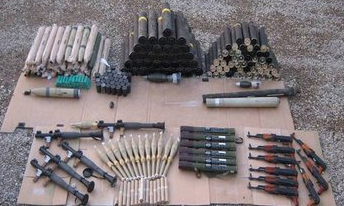
Insurgent arms cache, Baghdad 2008. Note distinctive black heat guard (used on Iranian models) in place of the RPG-7’s traditional varnished-wood guard (bottom left). Also note Iranian-made 107mm rockets (top left), 81mm mortars (top right) and 120mm mortars (top center).
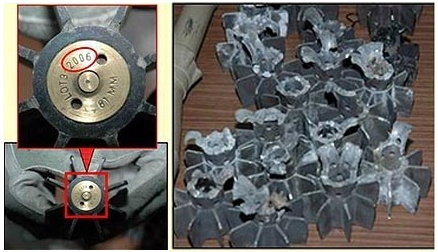
Excerpt from a U.S. government slideshow showing the remains of Iranian mortar tail-fins recovered after attacks in Iraq in late 2006. The fin configuration and design and lot number configuration identify them as Iranian munitions.
Also in 2007, American troops discovered over 100 Austrian made Steyr HS50 .50 caliber sniper rifles in Iraq. These high-powered sniper rifles, which fire Iranian bullets, can pierce all in-service body armor from up to a mile and penetrate U.S. armored Humvee troop carriers. The rifles were part of a larger shipment legally purchased from the Austrian manufacturer by Iran a year previously under the justification that they would be used by Iranian police to combat drug smugglers. Although there was concern in both Washington and London at the time, the sale went through and the weapons were shipped to Iran. The presence of such weapons demonstrates a high level of sophistication in the Iranian arms flow into Iraq, as the purchase was made officially by the Iranians.
18
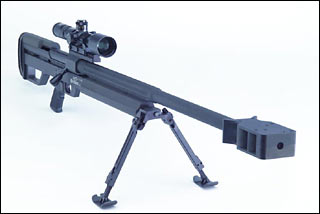
American troops discovered over 100 Austrian-made Steyr HS50 .50 caliber sniper rifles in Iraq, part of a shipment of 800 legally purchased by Iran. The Iranian rifles were also provided to Hamas and Islamic Jihad fighters in Gaza, shown below training.
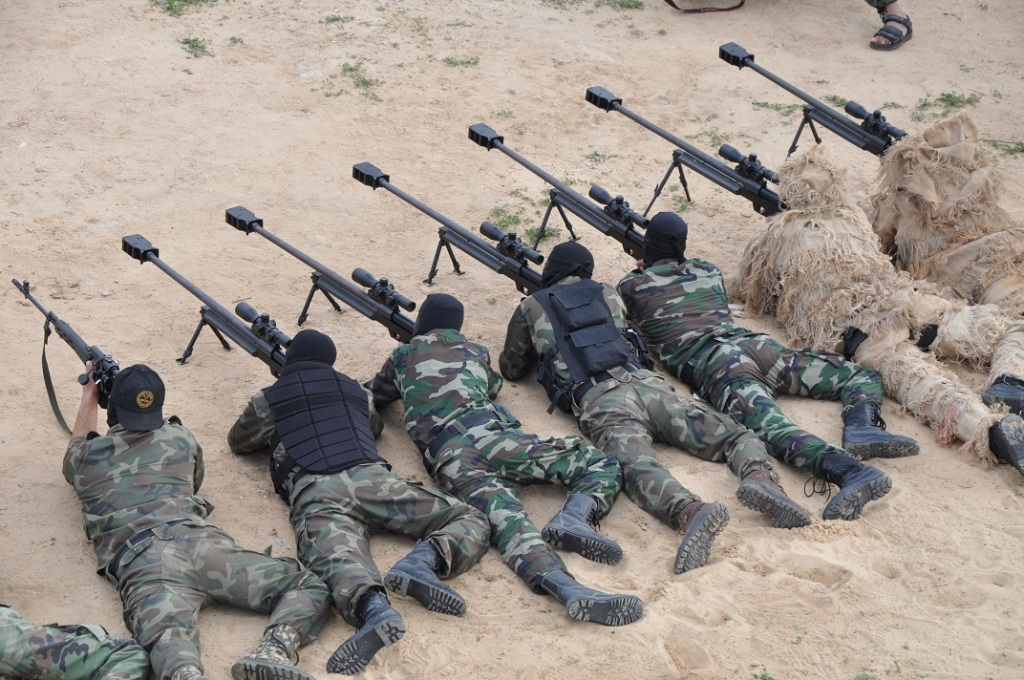
Islamic Jihad snipers
Killing U.S. and Allied Troops in Afghanistan
Although they previously opposed the Taliban in Afghanistan during the conflict there since 2001, Iran has provided support to enhance Taliban capability to kill U.S. forces and their allies. It is not clear exactly when this support began. It has been conducted primarily through the IRGC as in Iraq, although on a smaller scale. Support has included provision of munitions, funding, training and allowing transit through Iranian territory to Taliban fighters.
U.S. and other NATO forces have intercepted shipments of Iranian-made arms in Afghanistan, including mortars, plastic explosives and the same type of EFPs that were used to attack U.S. and allied armored vehicles and to kill soldiers in Iraq. William Wood, former U.S. Ambassador to Afghanistan (from 2007–2009) said in 2008: “There is no question that elements of the insurgency have received weapons from Iran.”
19
According to the U.S. State Department in its
Country Reports on Terrorism for 2009:
20,21
Iran’s Qods Force provided training to the Taliban in Afghanistan on small unit tactics, small arms, explosives, and indirect fire weapons. Since at least 2006, Iran has arranged arms shipments to select Taliban members, including small arms and associated ammunition, rocket-propelled grenades, mortar rounds, 107mm rockets, and plastic explosives.
According to a RAND report: “Although Iran has traditionally backed Tajik and Shi’a groups opposed to the Taliban, its enmity with the United States and tensions over the nuclear program led it to provide measured support to the Taliban.”
22
In 2008, UK Special Forces operators reportedly obtained evidence indicating that Iran was supplying components for EFPs to Afghan insurgents.
23 Iran paid Taliban fighters $1,000 for each U.S. soldier they killed in Afghanistan. A man described by
The Sunday Times as a “Taliban treasurer” had reportedly received $18,000 from an Iranian firm in Kabul as a reward for an attack in 2010 that killed several Afghan government troops and destroyed an American armored vehicle.
24
The discovery of the first caches of Iranian-made weapons in Afghanistan in April 2008, according to an unnamed U.S. State Department official at the time, “sent shock waves through the system.”
In 2009 General Petraeus, then Commander of U.S. CENTCOM, confirmed that Iran was providing equipment, explosives and perhaps also funding to the Taliban in western Afghanistan. He considered that this was not because Tehran wanted the Taliban to succeed, but because they saw it as a way of hitting the U.S.
25
In May 2010, General Stanley McChrystal, then NATO commander in Afghanistan, said that Iran was training Afghan fighters inside Iran. And in March of that year, Admiral Mike Mullen, Chairman of the U.S. Joint Chiefs of Staff, informed Congress that large-scale weapons shipments from Iran had been intercepted bound for Afghanistan.
26
An uncorroborated media report in 2010, allegedly from a CIA source, suggested that the Taliban had been supplied by Iran with 36 Iranian shoulder-launched SA-7 surface-to-air missiles. An Afghan intelligence report at around the same time suggested that Iran had provided a re-supply of SA-7 batteries for these missiles.
27 On May 30, 2007, a U.S. CH-47 Chinook was shot down in the upper Sangin valley, killing five American soldiers, one British soldier and one Canadian soldier. Until July 25, 2010, its downing was officially attributed to small arms and a rocket-propelled grenade. However, subsequent investigations by coalition forces revealed that it was downed by a man-portable air defense weapon (MANPAD). Prior to that, Coalition forces generally downplayed or even denied any form of MANPAD attack by Taliban insurgents.
28
Members of the Afghan Parliament have accused Iran of setting up Taliban bases in several Iranian cities, and that “Iran is directly involved in fanning ethnic, linguistic and sectarian tensions in Afghanistan.”
29 In March 2012, Najibullah Kabuli, leader of the National Participation Front (NPF) of Afghanistan, which opposes the return of the Taliban to power, accused three senior leaders of the IRGC of plotting to assassinate him.
30
Forty-eight 122mm rockets were seized in an ISAF raid in Nimruz province on February 5, 2011. British Foreign Secretary William Hague said: “The detailed technical analysis, together with the circumstances of the seizure, leave us in no doubt that the weaponry recovered came from Iran.” General Petraeus, then Commander of NATO forces in Afghanistan, confirmed this during testimony to the Senate Armed Services Committee in March of that year.
31
Petraeus asserted that the IRGC-QF had supplied forty-eight 122 millimeter rockets to a “known Taliban facilitator.” He told the committee that the rockets had twice the range of the 107 mm rockets normally used by the Taliban, with “twice the bursting radius.” He re-affirmed that Iran, without question, provides weapons, training and funding to the Taliban. He noted that such support was carefully measured to hit U.S. forces while not allowing the Taliban to succeed.
32
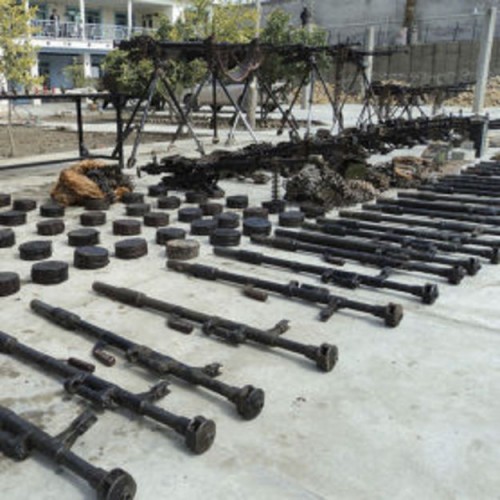
Iranian weapons recovered in an ISAF raid on 5 February 2011 in Nimruz province, Afghanistan.
In February 2014, the U.S. Treasury Department added to its list of global terrorists three IRGC officers and one “associate” who are involved in the “use of terrorism and intelligence operations as tools of influence against the Government of the Islamic Republic of Afghanistan.” The designation of the four IRGC operatives “underscores Tehran’s use of terrorism and intelligence operations as tools of influence against the Government of the Islamic Republic of Afghanistan,” according to the Treasury Department.
33
There has been no reliable estimate of the number of U.S. and allied soldiers killed in Afghanistan as a result of Iranian support to extremists there. The figure will be lower than the 1,100 U.S. deaths in Iraq that are estimated as attributable to Iran, but nevertheless, we can be certain that Iranian action has killed U.S. and allied troops in Afghanistan.
Killing Americans and Allies Globally
Iran’s sponsorship of terror is intended to achieve two strategic goals: first, undermining the U.S.-led effort to isolate Iran; and second, bridging the Shiite-Sunni divide in order to build a pan-Islamic, anti-American front. To achieve these objectives, Iran has backed an array of terrorist organizations. According to the U.S. State Department, in its
Country Report on Terrorism for 2013, Iran has funded or facilitated terror activity in more than a dozen countries, stretching from the Persian Gulf to the Mediterranean Sea and beyond.
Supporting Al Qaida
Although Iran is Shia and Al Qaida Sunni, and although they have different goals, Iran and Al Qaida have sometimes made common cause in view of their common adversary, the U.S. A shared willingness to cooperate against the U.S., despite their theological differences, has spawned an important tactical relationship.
An active Al Qaida network operates today in Iran with the full knowledge and support of the regime. Led by the Syrian-born Yasin al-Suri, this network organizes the movement of Al Qaida terrorists, documentation and funding from and through Iran to Pakistan, Afghanistan and the West. Al-Suri’s role was first exposed by the U.S. Treasury and State Departments in 2011. In December of that year, the U.S. government began offering a $10 million reward for information leading to al-Suri’s capture.
34
Recent terrorist plots in Europe, the U.S., Canada, and against Western targets in Egypt have been linked to al-Suri’s Iran-based cells.
35 Links have also been identified between this Al Qaida network in Iran and the 7/7 bombings in London as well as a planned attack against Heathrow Airport in 2006. Al-Suri’s group also supports the Al Qaida al-Nusrah Front in Syria by helping to transfer funds from donors in the Gulf and Kuwait.
In February 2012, the U.S. Treasury Department designated the Iranian Ministry of Intelligence and Security (MOIS) as a terrorist-sponsoring entity for, among other things, supporting Al Qaida and Al Qaida in Iraq’s operations.
36 More recently, as documented by the U.S. State Department in its
Country Report on Terrorism for 2013, Iran has repeatedly resisted numerous calls to transfer custody of its Al Qaida detainees to their countries of origin or third countries for trial.
37
Islamic State
Closer to home, Al Qaida in Iraq, now known as the Islamic State (IS), has benefited not only from al-Suri’s network, but also from funding and weaponry supplied by the MOIS. There is a strong likelihood that this support continues today, even as Iranian forces aid opposing Shia militia groups in Iraq, and engage in battle against the IS. To squeeze out moderates in the center, as well as to hedge their bets against a range of potential outcomes in Syria and Iraq, Iran has effectively been facilitating both sides of the conflict.
38
Attack Plans against the U.S.
In 2011 the IRGC attempted to assassinate the Saudi Arabian ambassador to the U.S. by blowing up a Washington restaurant. Iranian-born U.S. dual-national, Mansour Arbabsiar was arrested by U.S. authorities and pleaded guilty in a New York court to participating in the plot.
39 U.S. Attorney General Eric Holder stated that the plot was “directed and approved by elements of the Iranian government and, specifically, senior members of the Qods Force.”
40
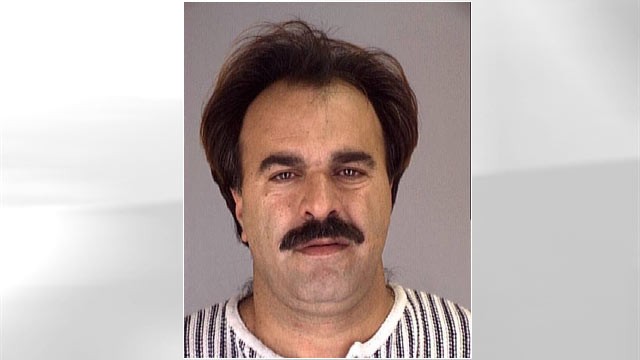
Iranian-born U.S. dual-national Mansour Arbabsiar pleaded guilty to participating in the 2011 failed plot to assassinate the Saudi Arabia ambassador to the U.S. by blowing up a Washington restaurant. He was sentenced to 25 years in prison. His accomplice, Gholam Shakuri, an Iran-based member of Iran’s Qods Force, remains at large. (Photo: Corpus Christi Sheriff’s Department)
In April 2013, a joint U.S.-Canada investigation thwarted a terrorist plot by two co-conspirators to derail a Canadian passenger train carrying passengers between Toronto and New York. One of the perpetrators, Chiheb Esseghaier, a Tunisian-born doctoral student, is believed to have travelled to Iran within two years of the attempted attack. Canadian police said the two men had received “direction and guidance” in the plot from “Al Qaida elements in Iran.”
41
Repeated Congressional testimony from senior American security and defense officials has revealed Hizbullah cells are present in the U.S. They are known to be engaging in surveillance, fund-raising and acquisition of military technology. Notable examples include:
- In 2002, two men in North Carolina were tried and convicted for providing material support to Hizbullah through racketeering and conspiracy to commit money laundering by channeling profits from cigarette smuggling to purchase military equipment for Hizbullah.42
- In 2006, former FBI Director Robert Mueller confirmed that Hizbullah supporters attempted to cross the Mexican border into the U.S. Although the perpetrators were caught by the FBI, the cross-border attempt demonstrates Hizbullah’s willingness to insert operatives inside the U.S.43
- In 2007, Texas Homeland Security Director Tom McCraw claimed that additional terrorists affiliated with Hamas and Hizbullah had been captured trying to cross the Mexican border.44
- In 2007, the U.S. Department of Treasury declared that Goodwill Charitable Organization Inc. in Dearborn, Michigan, was a fundraising front for Hizbullah, closed the organization’s offices and froze its assets in U.S. financial institutions.45
Iran has regularly threatened to launch spectacular attacks, including suicide attacks, drone strikes and missile technology, against American assets.
46 Iranian Naval Commander Rear Admiral Ali Fadavi, a member of the IRGC, said that Iran is constantly training and preparing for a clash with the U.S.
47 In May 2014, IRGC Navy Forces Commander Brig. Gen. Ali Fadavi described targeted Iranian preparations to sink U.S. aircraft carriers:
Today the Americans and the entire world know that one of our operational goals is destroying U.S. Navy Forces….Aircraft carriers provide U.S. airpower in combat; therefore it is natural that we want to sink them….Americans are unaware of many matters. Their research centers analyzed the mock aircraft carrier in a common way. We have been building and sinking mock U.S. destroyers, frigates, and cruisers for years. We sank their models [mock-ups of destroyers, frigates, and cruisers] within 50 seconds even with various operational [counter] measures….We will execute this regarding the mock aircraft carrier as well because destroying, annihilating, and sinking U.S. boats has and will be in our plans.48
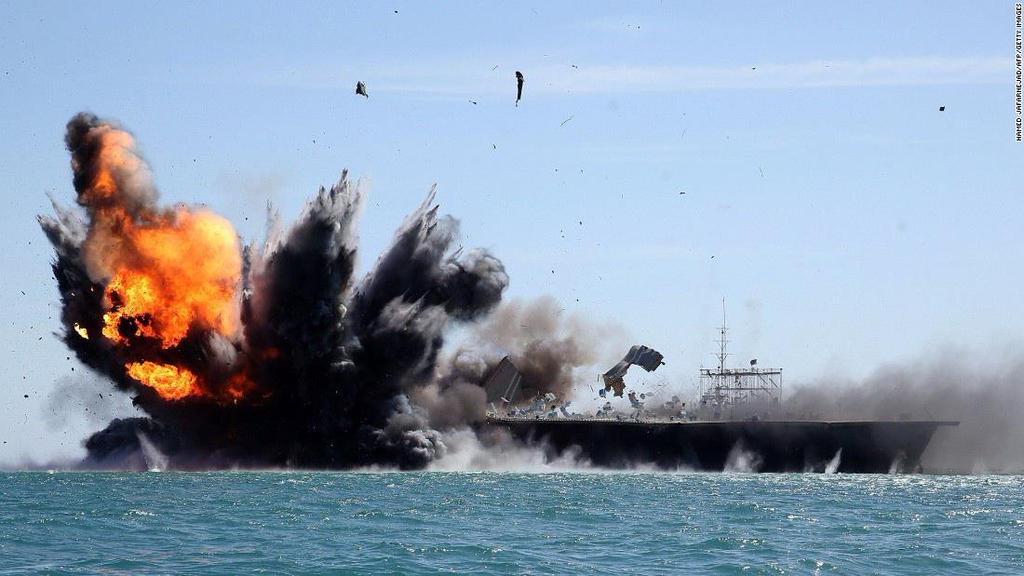
While Iran negotiates an agreement with the West on its nuclear program, it holds naval exercises near the Straits of Hormuz, sinking a mock-up of the USS Nimitz, an American aircraft carrier. (AFP Photo/Fars News/Hamed Jafarnejad)
The threat level goes beyond mere rhetoric. On February 27, 2015, the IRGC announced that it test-fired a “new strategic weapon” on the final day of a large-scale naval and air defense drill, emphasizing the system would play a key role in any future battle against the U.S. Adm. Ali Fadavi, the IRGC’s naval chief, said, “The new weapon will have a very decisive role in adding our naval power in confronting threats, particular by the Great Satan, the United States.”
49
In May 2014, the U.S. cyber security company, iSight Partners, uncovered a cyber-espionage campaign targeting hundreds of high-ranking U.S. and Israeli defense, diplomatic and other officials through social media networks.
50 The hackers sought to obtain intelligence that could support weapon systems development, or provide insight into the U.S. military, the U.S.-Israel alliance or nuclear negotiations between Iran and the U.S. and other powers, the report said.
51 Subsequent reports showed the sophistication of the scheme and suggests a government entity was behind the hacking – namely, the Iranian government.
52 “It is such a complex and broad-reaching, long-term espionage campaign for the Iranians,” said Tiffany Jones, a senior vice president at iSight and a former National Security Council aide in the George W. Bush administration. “What they lack in technical sophistication, they make up in creativity and persistence.”
53
Fueling the Conflict in Syria
Iran provides arms, financing, training and the facilitation of Iraqi Shia fighters to the Assad regime’s war, which has resulted in the death of more than 200,000 civilians in Syria. Iran has publicly admitted sending members of the IRGC to Syria in an advisory role. There are reports indicating some of these troops are IRGC-QF members, and that they have taken part in direct combat operations. In February 2013, senior IRGC-QF commander Brig. Gen. Hassan Shateri was killed in or near Zabadani, Syria. This was the first publicly announced death of a senior Iranian military official in Syria. In November 2013, IRGC-QF commander Mohammad Jamalizadeh Paghaleh was also killed in Aleppo, Syria. Subsequent Iranian media reports stated that Paghaleh was volunteering in Syria to defend the Sayyida Zainab mosque, which is located in Damascus. The location of Paghaleh’s death, over 200 miles away from the mosque he was reported to be protecting, indicates Iran’s intent to mask the operations of IRGC-QF forces in Syria.
54
According to the U.S. State Department in its
Country Report on Terrorism for 2013, Iran was facilitating the transfer of both Shiite and radical Sunni fighters into Syria, essentially funding both sides of the country’s conflict and targeting moderate Sunni rebel groups. The report also confirmed that Iran “trained, funded, and provided guidance to Iraqi Shia militant groups,” which had been done “despite [Iran’s] pledge to support Iraq’s stabilization.”
Tehran views the Syrian conflict as an extension of Iran’s war with the U.S. IRGC Commander Col. Mohammad Eskandari said, “IRGC commanders have prepared and equipped 42 divisions and 138 battalions in [Syria], and are fully prepared to fight the enemy….Today’s war in Syria is really our war with America.
55 Iranian officials in June 2014 were reportedly trumpeting Assad’s anticipated reelection as a defeat for the U.S. and “celebrating not only the affirmation of Assad’s continued hold on power that the election represents, but also Iran’s role in sustaining him.”
56
Killing America’s Israeli Allies
The Iranian government views its actions against Israel as serving two purposes: firstly, to destroy the Jewish State; and second, to attack one of the most important U.S. allies in its ongoing war against the U.S. Iranian Supreme Leader Ayatollah Ali Khamenei said on July 23, 2014 that he believes there is only one solution for the “cancer” that is Israel: annihilation. “Israel’s annihilation is the only real cure.”
57
According to the U.S. State Department in its
Country Report on Terrorism for 2013, Tehran has “historically provided weapons, training and funding to Hamas and other Palestinian terrorist groups.”
58 Israel has long asserted that Iran is arming Gaza terrorists with advanced weaponry, which is then used to target Israeli civilians.

Military equipment confiscated from MV Karine A in January 2002. The vessel was found to be carrying 50 tons of weapons, including short-range Katyusha rockets, antitank missiles, and high explosives – all linked to Iran and Hizbullah.
During the second intifada, in January 2002, Israel interdicted a ship carrying roughly 50 tons of Iranian-supplied arms bound for Palestinian militant groups, including Hamas in the Gaza Strip. Purchased by the Palestinian Authority (PA) in Lebanon, the
Karine A had sailed from Sudan to Yemen and then to an Iranian island where it was loaded with 50 tons of war material including:
59
- 345 long- and short-range Katyusha rockets plus 10 launchers.
- 29 mortar tubes and 1,545 shells.
- 6 Sagger wire-guided anti-tank missile launchers and 10 missiles.
- 51 RPG-7 anti-tank missiles and 328 rockets.
- 30 high-powered Dragonov telescopic rifles.
- 212 Kalashnikov assault rifles.
- 2,000 kilograms of explosives.
- 2 high-powered Yamaha engine speedboats with diving equipment.
- 311 anti-personnel mines.
- 211 anti-tank mines.
- 700,000 rounds of small arms ammunition.
- 735 hand grenades.
The Iranians agreed to deliver the weapons to Yasser Arafat’s group in exchange for him allowing the IRGC to establish a foothold in Palestinian towns and cities of the West Bank and Gaza.
60 Had the weapons successfully entered Gaza, Hamas would have been capable of saturation-bombing major Israeli population centers and transportation arteries.
Iran continues to facilitate the flow of weapons into Gaza. In March 2014, the Israel Navy boarded and seized the
Klos-C, a Panamanian-flagged Iranian arms ship carrying, among other things, advanced M302 missiles bound for the Hamas-controlled Gaza Strip and two million kilograms of Iranian cement for Hamas’ attack tunnels. From Syria the missiles had apparently traveled through Iran and Iraq before being intercepted by Israel on the high seas. M302 missiles have a range of 200 km., enabling any group that possessed them to reach across Israel. Hamas has fired such missiles at Tel Aviv and cities in the north of Israel.
61
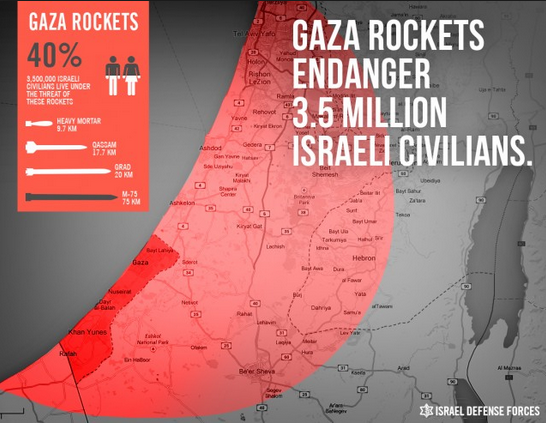
Map depicting the range of Hamas rocket fire from the Gaza Strip, courtesy of the IDF.
On November 21, 2012, Iran admitted supplying the technologies behind the construction of Fajr-5 missiles, which have a range of up to 75 km., but denied any direct arms supplies.
62 Ali Larijani, speaker of the Iranian parliament, said his country was “honored” to help Palestinians with “material and military aspects.”
63 However, a panel of UN experts has concluded that “a shipment of rockets and other weapons seized by Israel came from Iran and represents a violation of the UN arms embargo on Tehran.”
64 The report specifically cites the March 2014 interdiction of the
Klos-C. On August 4, 2014, senior Iranian officials, including IRGC commander Mohammad Ali Jafari, boasted that Tehran had supplied Hamas with military aid to use against Israel.
65 “The Zionist regime will collapse soon as a result of the unity among Shia and Sunni Muslims and we are ready for that day,” he said.
66
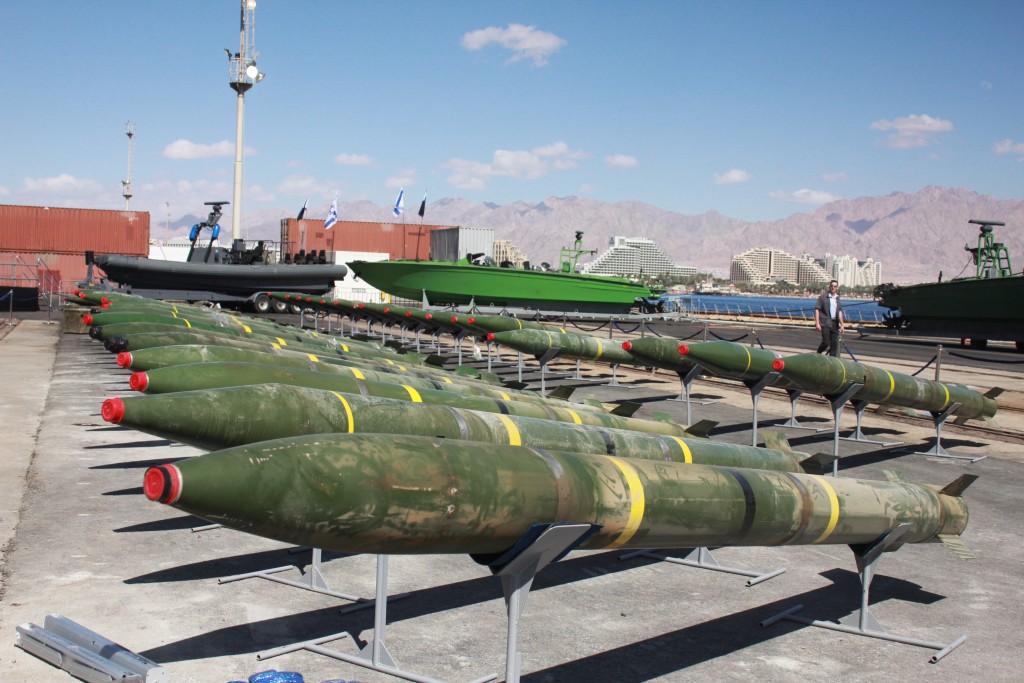
On March 5, 2014 an Israeli Navy task force seized the Iranian-owned merchant vessel Klos-C that had set sail from Iran, heading for Port Sudan via Iraq. On board, the commandos found long-range missiles concealed in containers full of Iranian bags marked as Portland cement. (Photo credit: IDF Spokesman)
The former head of Israel’s navy, Vice Admiral Eliezer Marom, said that Iran was the leading arms smuggler to the Middle East, and that his country was engaged in an “ongoing secret war between Israel and terrorist organizations and the evil axis led by Iran,” to fight that threat.
67 On November 4, 2009, the Israeli Navy seized the
MV Francop cargo ship in the eastern Mediterranean Sea along with its cargo of weapons allegedly bound from Iran to Hizbullah. The arms shipment, which weighed 320 tons and was held in containers marked with Iranian shipping codes, contained:
- 9,000 mortar shells.
- Several thousand 107-mm Katyusha rockets with a 15-km. range.
- 600 Russian-made 122-mm rockets with a 40-km. range.
- Hundreds of thousands of Kalashnikov bullets.68
According to retired Israel Defense Forces Lt. Col. Michael Segall, Iran and Gaza-based terrorist organizations took advantage of periods of calm to rebuild their terrorist infrastructure and build arsenals capable of reaching most of Israel, as seen during the 2014 Gaza War.
69 With no Arab states stepping forward to offer support for Hamas, Iran stepped in to fill the vacuum.
70
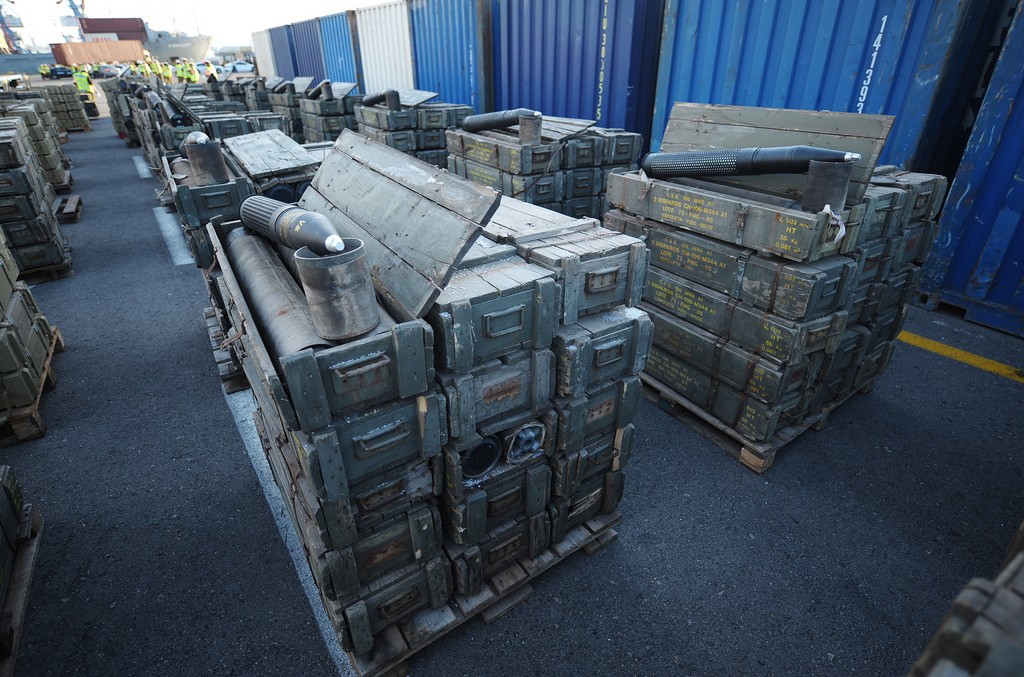
On November 4, 2009 the Israeli Navy seized the MV Francop cargo ship in the eastern Mediterranean Sea along with its 320-ton cargo of weapons allegedly bound from Iran to Hizbullah. (Photo credit: IDF Spokesman)
A significant number of the rocket attacks from Gaza against Israel before and during the Gaza conflicts in 2008-09, 2012 and 2014 were enabled by Iranian supply of munitions and funds to Hamas, Palestinian Islamic Jihad and other groups. There was a period of friction between Hamas and Hizbullah, because Hamas endorsed a revolt against the regime of Bashar al-Assad, depriving Assad of an important Sunni Muslim supporter. However, meetings between Hamas and Hizbullah, including with Hizbullah Chief Hassan Nasrallah, have indicated a renewal of cooperation and thereby of Iranian support for and influence on Hamas.
71,72
In the Golan Heights the IRGC is seeking to build another front from which to direct attacks against Israel. The IRGC has attempted to establish a fusion of Iranian and Hizbullah forces to conduct cross border raids against IDF troops from neighboring Syria. An Israeli drone attack in southern Syria killed six Hizbullah and IRGC personnel involved in this plan — including an Iranian senior general and senior Hizbullah commander Jihad Mugniyeh, the son of the late external operations chief for Hizbullah. IRGC-QF leader Qassem Soleimani dispatched two officers to Lebanon to facilitate a revenge attack. On January 28, 2015, Hizbullah fired five anti-tank guided missiles at an Israeli army convoy on Mount Dov, killing two Israeli soldiers.
Beyond the Region
Hizbullah, probably under Iran’s direction and certainly with Iran’s approval, has also launched other attacks against Israel outside the Middle East.
In 2012, a bus carrying Israeli tourists at the Sarafovo Airport in Burgas, Bulgaria, was bombed. Five Israelis and the Bulgarian driver were killed and 32 Israelis were wounded.
73 Bulgaria’s Chief Prosecutor Sotir Tsatsarov announced the identities of two suspects, Australian citizen Meliad Farah, 32, also known as Hussein Hussein, and 25-year-old Hassan El Hajj Hassan, a Canadian citizen. The suspects are alleged by the prosecutors to be members of the armed wing of Hizbullah.
74
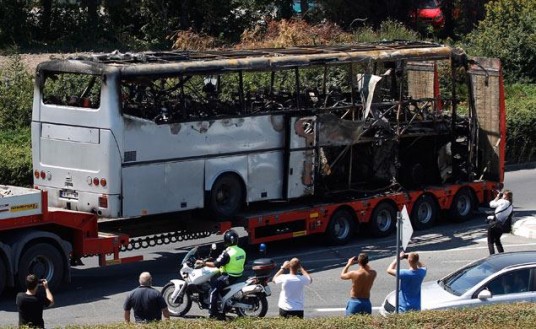
Following the Burgas bus bombing investigation, the Bulgarian government found Hizbullah and Iran responsible for the attack.
In March 2012, U.S. and Israeli officials were among those targeted for assassination by a group of IRGC-linked terrorists arrested in Baku, Azerbaijan. The attempts were part of a broader campaign by Iran-linked operatives to kill foreign diplomats in at least seven countries over a span of 13 months.

Weapons and ammunition seized in March 2002 from IRGC-linked terrorists who planned to assassinate U.S. and Israeli officials in Baku, Azerbaijan.
ANNEX A – HIZBULLAH: HISTORIC KILLING
Hizbullah has a lengthy track record of attacks against the U.S. and its allies. This annex outlines attacks before 2001 in which Hizbullah’s involvement is known or suspected. In these attacks, a total of 442 people were killed, including 286 Americans. More than 1,030 were wounded.
- From 1980-1988 the U.S. supported Saddam Hussein in the Iran-Iraq war. During that time, 96 foreign nationals (including 30 Westerners) were taken hostage, mainly by Hizbullah, in systematic abductions. Iran then used the hostages as leverage to obtain arms from the Reagan administration.75
- In 1983 Hizbullah bombed the U.S. Embassy in Beirut, Lebanon, killing 63 people including 17 Americans and wounding more than 80. Hizbullah operatives were responsible for the bombing and received both financial and logistical support from Tehran. The attack constituted the deadliest terror attack on Americans outside of U.S. soil until the U.S. marine barracks bombing six months later.76
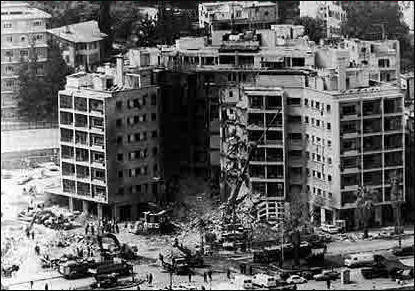
U.S. Embassy in Beirut. The attack constituted the deadliest terror attack on Americans outside of U.S. soil.
- In 1983, Hizbullah bombed a U.S. marine barracks in Beirut, Lebanon, killing 241 U.S. servicemen and wounding more than 100. The bombing – which consisted of 15,000-21,000 pounds of TNT – was the “largest non-nuclear explosion that had ever been detonated on the face of the Earth.”77
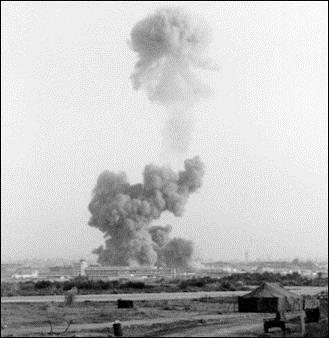
The U.S. Marines HQ immediately following the huge detonation in Oct. 1983. “The largest non-nuclear explosion that had ever been detonated on the face of the Earth.” Although Hizbullah and IRGC were believed to have planned and executed the attack, no arrests were ever made.
- In 1984, CIA Beirut Station Chief William F. Buckley was kidnapped outside his apartment and whisked to a terrorist-safe house. The U.S. Embassy received a package containing a video of the kidnapped CIA officer. In it, Buckley was shown lying on the floor, appearing beaten and naked and holding a file marked “Top Secret” to cover his genitals. Another video was sent less than a month later showing Buckley in an even worse condition. CIA experts concluded he was being regularly drugged, had undergone long periods of torture and was being held in a makeshift cell with no light. This was the work of Hizbullah leader Imad Mughniyeh.78 Buckley is believed by the CIA to have died in captivity.
- In 1984, Kuwait Airways Flight 221 from Kuwait to Pakistan was hijacked and diverted to Tehran. The hijackers demanded the release of the “Kuwait 17,” seventeen terrorists convicted by Kuwait for participation in the bombing of the U.S. Embassy there. The hijackers killed two American officials from the U.S. Agency for International Development. Iran arrested the hijackers, saying they would be brought to trial. The trial never took place, however, and the hijackers were allowed to leave the country.79
- In 1985, TWA Flight 847 was hijacked. Terrorists aboard the plane, en route from Athens to Rome, forced it to land in Beirut, Lebanon, where the hijackers held the plane for 17 days. They demanded the release of the “Kuwait 17” as well as the release of 700 fellow Shiite Muslim prisoners held in Israeli prisons and in prisons in southern Lebanon run by the Israeli-backed South Lebanon Army. When these demands weren’t met, Robert Dean Stethem, a U.S. Navy SEAL diver and passenger on the plan, was forced to kneel and was then shot in the head. His body was dumped on the tarmac.80
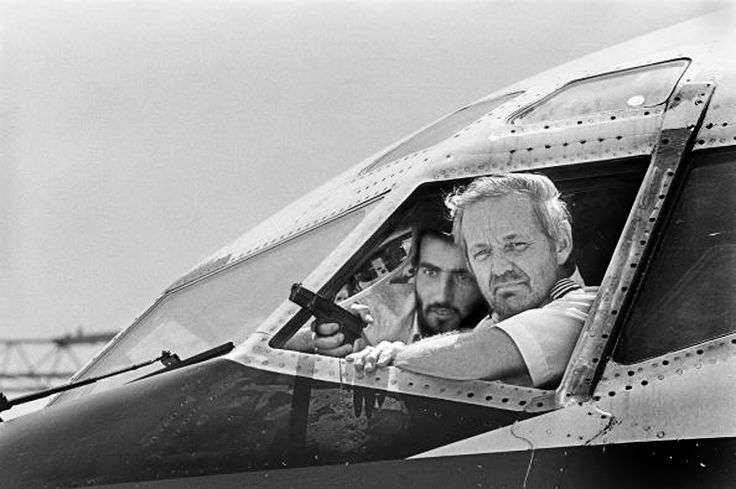
The Captain of TWA Flight 847 held at gunpoint by Hizbullah leader Imad Mughniyeh. When the terrorists’ demands weren’t met, Robert Dean Stethem, a U.S. Navy SEAL diver, was executed by the Iranian-backed hijackers.
- In 1988, U.S. Marine Lt. Col. William Richard Higgins was kidnapped, tortured and murdered. Higgins was driving on a coastal highway in southern Lebanon, when he was pulled from his jeep by Iranian-backed terrorists. About a year later, his kidnappers released a videotape of him bound and gagged, dangling from a rope on a makeshift gallows. He was declared dead on July 6, 1990, and his remains were dumped on a dusty street in Beirut on Dec. 23, 1991.81
- In 1992 the Israeli Embassy in Buenos Aires, Argentina was bombed, killing 29 and wounding 250. In 2008 Judge Ellen Huvelle ruled that Tehran must pay $63 million to the family of an Israeli diplomat who was killed in the attack. She said the bombing was carried out by Hizbullah and could not have taken place without assistance from Iran.82
- In 1994 the seven-story Jewish-Argentine Mutual Association (AMIA) community center in Buenos Aires, Argentina, was bombed. This is considered the deadliest attack in Argentina’s history, killing 85 and wounding 300. Mohsen Rezai and Ali Akbar Velayati, who are believed to have planned the attack, were among the eight candidates approved for the 2013 presidential election by Iran’s Guardian Council to succeed Mahmoud Ahmadinejad.83
- In 1996 Khobar Towers in Saudi Arabia was bombed, killing 23 Americans, including 17 U.S. servicemen, and wounding more than 300. In 1996 a U.S. federal judge ruled that Iran is responsible for the bombing and ordered that the government pay $254 million to the families of the 17 American servicemen who died in the attack.84
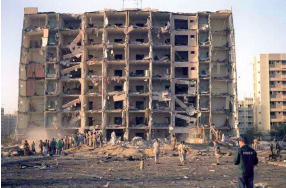
The 1996 Khobar Towers bombing in Saudi Arabia. The 9/11 Commission concluded that Hizbullah, with the support of the Iranian regime, was the perpetrator.
About the Authors
Colonel (ret.) Richard Kemp
Colonel Richard Kemp has been actively involved in fighting terrorists around the globe for 35 years. He served as Commander of British Forces in Afghanistan with responsibility for counter insurgency operations, disarmament and reintegration programs, development and training of the Afghan national security forces, reconstruction and defense diplomacy. He set up a joint counter-terrorist operation with U.S., Canadian and Afghan forces that achieved major operational success against Al Qaida terrorists in Kabul.
Colonel Kemp was an active member of the groundbreaking UK-U.S. Joint International Security Strategy Group. He headed the Joint Intelligence Committee’s international and domestic terrorism team and the Iraq politics and security team, responsible for UK national intelligence assessments. Among his responsibilities were intelligence assessments on Iranian-linked terrorism against British, American and other forces.
Previously Colonel Kemp completed a total of 14 active duty tours as a military commander in Northern Ireland and in many global hotspots. Working alongside U.S. forces, he took part in the liberation of Kuwait in 1991. He commanded British troops in the United Nations Protection Force in Bosnia and was counter-terrorism adviser to the Macedonian government. He was made Commander of the Order of the British Empire (CBE) for his work on the July 2005 London bombings and in Iraq; Member of the Order of the British Empire (MBE) for intelligence work in Northern Ireland; and was awarded the Queen’s Commendation for Bravery for his action during the Bosnia conflict.
He has commented frequently on Israel’s counter-terrorism actions in Gaza and stated about the Israel Defense Forces: “No army in the world acts with as much discretion and great care as the IDF in order to minimize damage. The U.S. and the UK are careful, but not as much as Israel.”
Major (Ret.) Chris Driver-Williams
Chris Driver-Williams has served 25 years in the British military and in private consulting in counter-terrorism, national infrastructure protection, blast and explosive engineering, and security and risk management.
He spent the majority of his military career as a high threat bomb disposal operator in the British Army and during that time he served with a variety of specialist counter-terrorism units including four years with the UK Special Forces. During his military career he deployed to the Balkans, Northern Ireland, Colombia, Afghanistan and Iraq, and for his actions during an Iraq bomb disposal tour he was awarded the Queen’s Gallantry Medal. He rounded off his military career as an intelligence officer, and at the time of the 2005 London suicide bombings, he played an instrumental role at COBR-A, the British Cabinet Office’s emergency response committee.
Research by Joseph Raskas
Notes
Cover photo: A U. S. Stryker vehicle lies on its side following a buried IED blast in Iraq in 2007.
2 Department of Defense. Unclassified Executive Summary. “Annual Report on Military Power of Iran.” January 2014
12 Bowers, Carol (2007-09-11). “Iran Playing ‘Destabilizing Role’ in Iraq”. US Department of Defense.
18 Iraq Report: Institute for the Study of War, Aug 2007
30 http://www.pajhwok.com/en/subscription-required?redirect_from=350660. Khwaja Baser Ahmad, ed. (4 March 2012). “Iran’s Revolutionary Guards plotting to kill me: Kabuli”. Pajhwok Afghan News. Retrieved 18 May 2013
37 Bill Gertz, “Al Qaida Terrorists Being Held by Iran,” , July 24, 2003.
43 “Lebanon: The Israel-Hamas-Hezbollah Conflict; CRS Report for Congress: Received Through the CRS Web.” Congressional Research Service.
44 Carlton, Jeff. “Security Chief Says Terrorists Have BeenArrested on Texas Border.” Associated Press State and Local Wire. 13 September 2007.
- See more at:
http://jcpa.org/killing-americans-allies-irans-war/#sthash.ffqAq1NK.dpuf
Iran linked to deaths of U.S.
troops in Iraq, Afghanistan
By Andrew deGrandpre and Andrew Tilghman,
Staff writers 11:15 a.m. EDT July 15, 2015
At least 500 U.S. military deaths in Iraq and Afghanistan
were directly linked to Iran
and its support for anti-American militants — a newly disclosed statistic that
offers grim context for the Obama administration's diplomatic deal with the
Iranian regime aimed at curtailing the rogue nation's nuclear ambitions.
That figure underscores the
controversy surrounding Washington's deal with Tehran, a long-sought goal for
the president — but one that is fiercely opposed by many Republicans in
Congress and other critics.
Many of those
estimated 500 deaths occurred during the so-called surge in Iraq, when
President George W. Bush ordered an influx of tens of thousands of troops to
confront what had devolved into a sectarian civil war. Scores of American
personnel were killed or maimed by highly lethal bombs, known as explosively
formed penetrators, or EFPs, that Iran
manufactured and supplied to Shiite militias across the border in Iraq. Many EFPs
were powerful enough to destroy U.S. Humvees and breach tank hulls.
The startling number emerged last
week as Sen. Tom Cotton, an Arkansas Republican and Army veteran who served as
an infantry officer in Iraq
and Afghanistan,
pressed the issue at a confirmation hearing for Marine Corps Gen. Joseph
Dunford, who is Obama's nominee to be chairman of the Joint Chiefs of Staff.
"Senator," Dunford
responded, "I know the total number of soldiers, sailors, airmen and Marines
that were killed by Iranian activities, and the number has been recently quoted
as about 500. We weren't always able to attribute the casualties we had to
Iranian activity, although many times we suspected it was Iranian activity even
though we didn't necessarily have the forensics to support that."
The Defense Department does not
specifically track casualties linked to Iran. The 500 estimate is a
ballpark figure based on intelligence assessments, according to a Pentagon
official familiar with Dunford's remarks.
The memory of those deaths was
surely a factor in the caution signaled by the Pentagon on Tuesday afternoon,
after Obama's announcement of this landmark deal between Iran, the U.S. and five other countries.
"As we implement this historic
agreement, deterrence remains a major component of America's national security,"
Defense Secretary Ash Carter said in a statement. The U.S. military
will remain ready to "check Iranian malign influence" and
"utilize the military option if necessary," he added.
The Iranian-made EFPs first
appeared in Iraq in 2005 and
for years were the most lethal weapon that American troops faced during the
eight-year Iraq
war.
Unlike the typical improvised
explosive devices U.S.
troops encountered there, the EFPs used more sophisticated technology and
required more skilled milling to produce. Also known as "shaped"
explosives, they used curved copper plates to direct or "shape" the
bomb blast.
The estimate of 500 American
deaths is probably on the low side, said David "Bo" Bolgiano, a
retired Army Special Forces officer who deployed to Iraq in 2006 and 2007 with the
Joint Improvised Explosive Device Defeat Organization, an organization created
by the Pentagon to rapidly address the number of casualties inflicted by roadside
bombs and other IEDs.
"It's very difficult to
quantify because, when you have an IED explosion that occurs in theater, you'd
have to connect the dots and say, 'Well, we have three U.S. casualties tied to
that IED,' and then that IED is tied to a specific copper-plated EFP from Iran.
Often times, those forensics are missing," Bolgiano said in an interview.
"The big EFPs from Iran were
fairly easy to identify because of the metallurgy involved and the copper plate
formation," he said. "We had beyond-a-reasonable-doubt proof that Iran was the
main supplier of the copper-plate EFPs," said Bolgiano.
Troops referred to them as
"IEDs," but that's not completely accurate, Bolgiano said.
"Improvised is a little bit
misleading because it makes it sound like a basement bomb-maker, and that was
not the case. The shaped charges, the copper plates, the components were
anything but unsophisticated. They were designed and at the level anything that
any other non-Western government would have," Bolgiano said.
U.S. soldiers inspect a humvee damaged in 2009
by an improvised explosive in Iraq. (Photo: David Rising, AP)
Cotton contends that number is
much greater than 500, with still more American troops wounded in action as a
result of Iran's influence
on U.S.
adversaries in both war zones.
A spokeswoman for the senator,
Caroline Rabbit, said Tuesday that Iran "has the blood of
hundreds of Americans on its hands and this deal only gives them billions of
dollars to continue killing Americans." She was unable to provide Military
Times with a more-detailed breakdown of those statistics, nor was the Pentagon.
American troops pulled out of Iraq in 2011 and returned last year as the
Islamic State group overran Iraqi forces in places U.S. troops fought and died to
liberate. In the eyes of many Iraq War veterans, to include some senior U.S. military officials, the Iraqi Shiite
militias with links to Iran
also have American blood on their hands.
In March, the top U.S. commander in the Middle
East said he hoped the strategy for defeating Islamic State
extremists will not involve an alliance with those groups.
"Three tours in Iraq commanding
troops who were brutalized by some of these Shia militias ... I will not — and
I hope we never — coordinate or cooperate with the Shia militias," Army
Gen. Lloyd Austin, chief of U.S. Central Command, told the Senate Armed
Services Committee last winter.
But after the demoralizing fall
of the city of Ramadi in May, the U.S. military
shifted its policy. Now, U.S.
warplanes are launching airstrikes in support of some Shiite militias fighting
the Islamic State under the command and control of the Iraqi government.
Dunford, who pending confirmation
will become only the second Marine to serve as the U.S.
military's top officer, referred to Iran
as a "malign force," telling lawmakers that, despite a nuclear
agreement, Iran will
continue to exert its influence across the Middle East.
One need look no farther than the Red Sea, where this past spring American
naval vessels moved to block an Iranian arms shipment bound for rebel forces
fighting the American-backed government in Yemen.
"If confirmed as the
chairman," Dunford said, "I'll make sure that our leadership has a
full range of military options to deal with Iranian activity."
In a statement, Cotton indicated
he believes the deal with Iran
is a mistake, principally because it comes with an infusion of "tens of
billions of dollars to finance its sponsorship of terrorism against the United States
and our allies."
"When I was a platoon leader
in Iraq, my soldiers and I
faced deadly roadside bombs, made and supplied by Iran," the statement read.
"I tried to reassure them, but I could only tell them to hope it wasn't
our day to die by Iran's
roadside bombs. If Iran
obtains a nuclear weapon, I fear the United States will only be able to
hope it isn't our day to die by an Iranian nuclear bomb."
The Iran Deal Is Worse Than Stupid — It’s Dishonorable Read
more at:
by David French July 15, 2015 3:29 PM
Yesterday, in the immediate aftermath of the Iran deal announcement, I posted a short comment
noting that Iran
is responsible for more than 1,000 American military deaths since 9/11. That’s
just a number, but for many of us those numbers have names — the names of men
we knew. I will never forget the horrible days in March and April 2008, when
Iranian-made IEDs periodically closed even the main supply route into our small
forward operating base. I’ll never forget the hero flights, standing at
attention as brothers carried the still bodies of their fallen comrades to
waiting Blackhawk helicopters. And I won’t forget about the people who are even
now learning to walk, and eat, and live again — recovering from horrific
wounds. Yesterday, I got an angry message from a friend from my Iraq
deployment, a man whose vehicle was destroyed by an Iranian-made IED. Some of
the blood on Iran’s
hands is his own. The American people need to clearly understand what their
president has done. He’s granting billions of dollars in sanctions relief to a
nation that put bounties on the heads of American soldiers. Iran isn’t ending its war against America. It’s
still working — every day — to kill Americans, including the Americans Barack
Obama leads as commander-in-chief of our armed forces. There is no honor in
this agreement. Moreover, there is no honor in leaving innocent Americans
behind — to rot in Iranian prisons — so that President Obama can declare peace
in his time. Compared to rewarding killers and turning its back on innocent
American prisoners, the Obama administration’s lies about the negotiations are
a small thing indeed. After all, dishonorable people do dishonorable things.
Every member of Congress should be made to answer this question: Do you believe
in rewarding regimes that place bounties on the heads of American soldiers? If
so, then tell the American people. But don’t tell them that this agreement
brings peace, because no reasonable definition of the term includes Iran’s deadly, 36-year-long terror campaign
against America
and its allies.
Read more at: http://www.nationalreview.com/corner/421228/undefined
Iran Is Responsible for More Than 1,000 American Military
Deaths Since 9/11
by David French
July 14, 2015 12:26 PM
I wanted to
highlight this report, by Colonel (ret.) Richard Kemp and Major (ret.) Chris
Driver-Williams, that comprehensively outlines Iran’s acts of war against the United States.
Some lowlights: Iranian military action, often working through proxies using
terrorist tactics, has led to the deaths of well over a thousand American
soldiers in Iraq and Afghanistan
over the last decade and a half. Throughout the course of the Iraq campaign, a variety of weapons flowed into
the country through direct purchases by the government of Iran. These
included Explosively Formed Penetrators (EFPs), a shaped charge designed to
penetrate armor. These weapons – often camouflaged as rocks – were identical to
those employed by Hizbullah against Israeli forces. In 2006, the British
Telegraph revealed that three Iranian factories were “mass producing” the
roadside EFP bombs used to kill soldiers in Iraq . . . Iran paid Taliban
fighters $1,000 for each U.S. soldier they killed in Afghanistan. The Sunday
Times reported that a Taliban operative received $18,000 from an Iranian firm
in Kabul as reward for an attack in 2010 that killed several Afghan government
troops and destroyed an American armored vehicle. The Obama administration’s
nuclear agreement is nothing more than a stimulus package for jihad. Billions
of dollars will flow into the world’s worst terror-exporting country — a sworn
enemy of the United States
— and it will soon enough even have (legal) access to international
conventional-arms markets. It can continue to export terror and even kill
American soldiers without breaching the nuclear agreement. Until Iran stops
trying to kill Americans and stops imprisoning Americans (including Saeed
Abedini, a pastor prosecuted merely because of his Christian faith), how can
any rational person trust its good faith?
Read more at:
http://www.nationalreview.com/corner/421159/iran-responsible-more-1000-american-military-deaths-911-david-french
One weapon is the explosively formed penetrator (EFP),
believed to be supplied by neighboring Iran. The EFP uses a passive
infrared sensor to detect radiation from a warm passing object (such as a
Humvee) and fires a semi-molten disc of heavy copper that can rip through
several inches of armor. Homemade? Hardly. EFPs are either milled or punched
with a 20-ton hydraulic press into a concave disc up to 11 inches in diameter.
The copper projectile has a velocity of 2000 meters per second. Hidden in foam
blocks disguised as roadside rocks or curbstones, the only unusual visible
feature is a coin-sized hole for the infrared lens (which troops have dubbed
'The Eye of Allah.')
Iran's Nuclear Timetable
June 17, 2015
Weapon Program: Nuclear
Mentioned Suspect Entities &
Suppliers:
Fordow
Fuel Enrichment Plant
Author:
Valerie Lincy and Gary Milhollin
This
report estimates how soon Iran
could fuel a nuclear weapon. With its thousands of gas centrifuges, Iran now has
the ability to enrich uranium to a grade suitable for use in nuclear reactors
or to a higher grade suitable for use in nuclear warheads. The data below,
which are based on reports from the International Atomic Energy Agency,
describe Iran’s
uranium stockpile, its centrifuges, and the rate at which its nuclear capacity
is growing. [a]
Highlights:
- By using the
approximately 9,000 first generation centrifuges operating at its Natanz
Fuel Enrichment Plant, Iran
could theoretically produce enough weapon-grade uranium to fuel a single
nuclear warhead in less than 2 months. This timetable is longer if Iran
operates fewer centrifuges, or feeds the machines with natural uranium
rather than low-enriched uranium.
- Iran's more
advanced IR-2m centrifuges, about 1,000 of which are installed at Natanz,
would allow Iran
to produce weapon-grade uranium more quickly.
- Iran's stockpile of
low-enriched uranium is now sufficient, after further enrichment, to fuel
approximately eight nuclear warheads.
- Because Russia has a ten-year contract to fuel Iran’s only power reactor at Bushehr, Iran has no present need for
enriched uranium to generate civilian nuclear energy.
- Iran could fuel
approximately 25 first generation implosion bombs if it had the ability to
enrich the uranium needed to supply the Bushehr reactor annually.
Bomb potential of Iran's
low-enriched uranium
- Total amount of
uranium hexafluoride (UF6) enriched to approximately 3.5 percent U-235
produced as of May 2015:
14,937 kg [b]
- Amount of this
material ready for further enrichment (i.e., stored in gaseous form) as of
May 2015:
8,715 kg [c]
- Amount
theoretically needed to produce a bomb's worth of weapon-grade uranium
metal:
1,053 kg [d]
- Number of first
generation implosion bombs this 8,715 kilograms could fuel, if further
enriched:
8 [e]
- Time needed to
convert this uranium to one bomb's worth of finished uranium metal
enriched to 90 percent U-235:
3 - 12 months [f]
- Date by which Iran's
uranium stockpile probably was sufficient to fuel one first generation
implosion bomb, if further enriched:
February 2009 [g]
- Approximate
number of first generation IR-1 centrifuges being fed with UF6 at the
Natanz Fuel Enrichment Plant, as of the last reported visit by IAEA
inspectors:
9,000 [h]
- Number of months
theoretically needed for these 9,000 centrifuges operating at their
present capacity to produce enough enriched uranium for one
bomb:
1.6 [i]
Civilian need for this uranium
- Approximate
amount of low-enriched uranium needed annually to fuel Iran’s
sole civilian power reactor at Bushehr:
21 metric tons [j]
- Percent of this
uranium Russia
will supply under a ten-year fuel contract:
100 [k]
- Number of years
it would take the roughly 9,000 operating IR-1 centrifuges at Natanz to
produce one year's worth of fuel for Bushehr:
10.7 [l]
- Approximate
number of separative work units (amount of enrichment work)[m]
Iran
would need to generate in order to produce one year's worth of fuel for
Bushehr:
100,000 [n]
- Number of IR-1
centrifuges Iran
would need to operate in order to produce this level of work annually:
128,000 [o]
- Approximate
number of first generation implosion bombs Iran could fuel if able to
enrich the uranium needed to supply Bushehr annually:
25 [p]
Iranian Nuclear Breakout Times
Under Different Scenarios
If Iran
feeds its IR-centrifuges with natural
uranium and operates:
- 9,000 centrifuges
(the number now running):
6.8 months [q]
- 6,104 centrifuges
(the number allowed to be installed under the framework agreement):
10.1 months [r]
- 5,060 centrifuges
(the number allowed to operate under the framework agreement):
1 year [s]
If Iran
feeds its IR-centrifuges with low-enriched
uranium and operates: [t]
- 9,000
centrifuges:
1.6 months
- 6,104
centrifuges:
2.4 months
- 5,060
centrifuges:
2.9 months
Comments
- Before using
uranium in a warhead, it must be enriched to weapon-grade (90 percent or
more U-235) and processed into a metallic shape sufficient to explode in a
chain reaction.
- This assessment
assumes that Iran
would use 16 kg of weapon-grade uranium (~90 percent U-235) in the
finished core of each nuclear weapon. Sixteen kilograms are assumed
to be sufficient for an implosion bomb. This was the amount called
for in the implosion device Saddam Hussein was trying to perfect in the
1980’s, and the design for such a device has circulated on the nuclear
black market, to which Iran
has had access. Some experts believe that Iran
could use less material, assuming Iran would accept a lower
yield for each weapon. According to these experts, Iran could use as few as seven kilograms of
this material if Iran’s
weapon developers possessed a “medium” level of skill, and if Iran were satisfied with an explosive yield
slightly less than that of the bomb dropped on Hiroshima, Japan. [u]
If Iran
chose to use an amount smaller than 16 kg, the time required to make each
weapon would be less than estimated here. Or, in the amount of time
estimated here, Iran
could make a greater number of weapons. Iran
could decide not to use such a smaller amount of weapon-grade uranium if Iran
wanted to have more confidence that its weapons would work, or if it
wanted to reduce the size of its weapons by reducing the amount of high
explosive required.
- Iran has converted
337.2 kg of 20 percent enriched uranium gas (or 227.6 kg of uranium) into
oxide form, producing 162.3 kg of uranium, some of which has been used to
produce fuel for the Tehran Research Reactor. If it is not
irradiated in the reactor, this material could be returned to gaseous form
and enriched to weapon grade. However, it would not be sufficient to
fuel more than one nuclear weapon and it is unclear how long it would take
to convert and further enrich the material.
- Uncertainties
about the number of centrifuges that Iran is operating make it
difficult to draw a conclusion about the performance of individual
machines. An increase or decrease in the production rate could be
attributed to the fact that more machines were operating when IAEA
inspectors were not present at the plant, rather than because the machines
were operating more efficiently. [v]
A change in production rate could also be attributed to a decision by Iran to
lower the output of its centrifuges.[w]
- Following
start-up, centrifuge cascades must be operated for a time without product
withdrawal. This process is called passivation.
Growth of enrichment capacity at
the Natanz Fuel Enrichment Plant
Date of IAEA Inventory
|
IR-1 Centrifuges Being Fed with UF6
|
Other IR-1 Centrifuges Installed
|
17 Feb 2007
|
0
|
656
|
13 May 2007
|
1,312
|
820
|
19 Aug 2007
|
1,968
|
656
|
3 Nov 2007
|
2,952
|
0
|
12 Dec 2007
|
2,952
|
?
|
7 May 2008
|
3,280
|
2,624
|
30 Aug 2008
|
3,772
|
2,132
|
7 Nov 2008
|
3,772
|
2,132
|
1 Feb 2009
|
3,936
|
1,968
|
1 Jun 2009
|
4,920
|
2,296
|
12 Aug 2009
|
4,592
|
3,716
|
2 Nov 2009
|
3,936
|
4,920
|
31 Jan 2010
|
3,772
|
4,838
|
24 May 2010
|
3,936
|
4,592
|
28 Aug 2010
|
3,772
|
5,084
|
5 Nov 2010
|
4,816
|
3,610
|
16 Nov 2010
|
0
|
~ 8,426
|
22 Nov 2010
|
~4,592
|
~3,834
|
20 Feb 2011
|
~5,184
|
~2,816
|
14 May 2011
|
~5,860
|
~2,140
|
28 Aug 2011
|
~5,860
|
~2,140
|
2 Nov 2011
|
~6,208
|
~1,792
|
19 Feb 2012
|
8,808
|
348
|
19 May 2012
|
8,818
|
512
|
21 Aug 2012
|
9,156
|
270
|
10 Nov 2012
|
9,156
|
1,258
|
19 Feb 2013
|
~8,990
|
~3,680
|
15 May 2013
|
~8,990
|
~4,565
|
24 Aug 2013
|
9,156
|
6,260
|
9 Nov 2013
|
~8,800
|
~6,620
|
10 Feb 2014
|
~9,000
|
~6,420
|
14 May 2014
|
~9,000
|
~6,420
|
13 Aug 2014
|
~9,000
|
~6,420
|
15 Oct 2014
|
~9,000
|
~6,420
|
8 Feb 2015
|
9,156
|
6,264
|
17 May 2015
|
9,156
|
6,264
|
Date of IAEA Inventory
|
IR-2m Centrifuges Being Fed with UF6
|
IR-2m Centrifuges Installed
|
19 Feb 2013
|
0
|
180
|
15 May 2013
|
0
|
689
|
24 Aug 2013
|
0
|
1,008
|
9 Nov 2013
|
0
|
1,008
|
10 Feb 2014
|
0
|
1,008
|
14 May 2014
|
0
|
1,008
|
13 Aug 2014
|
0
|
1,008
|
15 Oct 2014
|
0
|
1,008
|
8 Feb 2015
|
0
|
1,008
|
17 May 2015
|
0
|
1,008
|
Footnotes:
[a] The following estimates are based on information in quarterly
reports by the International Atomic Energy Agency (IAEA), which is responsible
for nuclear inspections in Iran. These quarterly reports are available
here: http://www.iranwatch.org/authoring-agency/iaea-report.
[b] Iran
continues to produce low-enriched UF6, which is allowed under the interim
accord. In all, Iran
has produced 14,936.7 kg of this material, which includes 115.6 kg that was
produced from the downblending of UF6 enriched to 20%. About 40% of Iran’s
low-enriched UF6 production has been either further enriched, or converted into
oxide form. According to the IAEA, Iran continues to produce
low-enriched UF6 at the rate reported by the Agency in the past, which was
estimated to be an average of 7.9 kg each day.
[c] Prior to the interim nuclear accord, Iran had used some of its
stockpiled low-enriched UF6 (~3,400 kg) for the production of 20% enriched
uranium gas. Under the accord, this production has been suspended and Iran has
downblended the 20% material to low-enriched UF6 or converted it to oxide
form. Iran
is also using centrifuges that had been producing 20% enriched uranium gas for
the production of low-enriched UF6. In both cases, this has led to an
increase in Iran’s
stockpile of low-enriched UF6. However, Iran has also begun converting a
portion of its low-enriched UF6 stockpile accumulated since January 2014
(~2,720 kg) into oxide form, thus reducing the size of the stockpile. As
a result of these activities, Iran
had approximately 8,715 kg of low-enriched UF6 as of May 2015, according to the
IAEA.
[d] This is assuming uranium tails of 1% U-235, a feed assay of 3.5%
U-235, a product assay of 90% U-235, a 20% loss of material during processing,
and that 16 kg of finished uranium metal enriched to 90% are needed for a
bomb. See the Separative Work Unit (SWU) calculator published by URENCO,
a European uranium enrichment consortium: web.archive.org/web/20021226100607/www.urenco.de/trennarbeit/swucal_e.html.
[e] If 1,053 kg of low-enriched uranium are required to produce a
bomb’s worth of weapon-grade uranium (see note d), the 8,715 kg of low-enriched
uranium in Iran’s stockpile as of May 2015 might be sufficient to fuel about
eight first generation implosion bombs.
[f] The IAEA estimates the conversion time for low-enriched uranium
to weapon-grade uranium metal to be approximately 3-12 months (www-pub.iaea.org/MTCD/publications/PDF/nvs-3-cd/PDF/NVS3_prn.pdf).
[g] According to the IAEA, Iran had produced about 1,010 kg of
low-enriched UF6 by late January 2009. Given the average daily production
rate of this material at the time, Iran's stockpile probably contained
the requisite 1,053 kg by the following month.
[h] As of May 2015, Iran
was operating 54 cascades of approximately 9,000 first-generation IR-1
centrifuges (9,156 according to the IAEA) in Production Hall A of the Natanz
Fuel Enrichment Plant.
[i] According to production data at the Natanz Fuel Enrichment Plant,
Iran's
IR-1 centrifuges have achieved an average annual output of about .78 Separative
Work Units, or SWUs, per machine. A SWU is a standard measure of the
effort required to increase the concentration of the fissionable U-235 isotope
within natural uranium. Based on the assumptions set forth above (see
note d), Iran
would need approximately 955 SWUs to bring 1,053 kg of low-enriched UF6 to
weapon grade. If each of Iran's
roughly 9,000 operating centrifuges produces an average of .78 SWUs per year,
their total output over one year would be 7,020 SWUs, or 585 SWUs per
month. Thus, it would take about 1.6 months to produce 955 SWUs.
[j] A typical 1,000 MWe pressurized light water reactor of the type Iran is
operating at Bushehr requires about 21 tons of low-enriched uranium fuel each
year. See the nuclear fuel cycle simulation system published by the IAEA
(http://infcis.iaea.org/NFCSS/NFCSSMain.asp?RightP=Calculation&EPage=2&Refresh=0&ReactorType=1).
[k] Russia and Iran signed a
nuclear fuel agreement in 1995. Under the agreement, Russia committed to supplying fuel for Bushehr
for ten years and Iran
committed to returning the spent fuel to Russia. Reportedly, the original
1992 nuclear cooperation agreement between Russia
and Iran stipulated that Russia would
supply fuel for the Bushehr reactor “for the entire lifespan of the nuclear
power plant.” See Mark Hibbs, “Iran’s Russia Problem,” July 7,
2014. (http://www.iranfactfile.org/2014/07/07/us-russia-split-wont-sink-iran-talks/)
[l] Iran
has achieved a low-enriched UF6 production rate of about 2,900 kg/year (7.9
kg/day), which contains 1,960 kg of uranium. At this rate, to produce 21
metric tons of reactor-grade uranium would take 10.7 years.
[m] The separative work unit, or SWU, is the standard measure of
the effort required to increase the concentration of the fissionable U-235
isotope. See http://urenco.com/index.php/content/89/glossary.
[n] See the nuclear fuel cycle simulation system published by the
IAEA (http://infcis.iaea.org/NFCSS/NFCSSMain.asp?RightP=Calculation&EPage=2&Refresh=0&ReactorType=1).
[o] This result assumes that the efficiency level of each
centrifuge stays at .78 SWU per machine (see note i).
[p] To produce a bomb’s worth of highly enriched uranium, it
takes approximately 4,000 SWUs. If Iran were able to produce 100,000
SWUs annually, and directed that power toward making nuclear weapon fuel, it could
make enough fuel for about 25 bombs.
[q] As of May 2015, Iran
was operating 54 cascades of approximately 9,000 first-generation IR-1
centrifuges (9,156 according to the IAEA) in Production Hall A of the Natanz
Fuel Enrichment Plant. To produce a bomb's worth of highly enriched
uranium from natural uranium, it takes approximately 4,000 Separative Work
Units, or SWUs. According to production data at the Natanz Fuel
Enrichment Plant, Iran's
IR-1 centrifuges have achieved an average annual output of about .78 SWUs per
machine. Thus, 9,000 centrifuges could produce fuel for one nuclear
weapon from natural uranium in an estimated 6.8 months.
[r] According to the State Department’s fact sheet, “Parameters
for a Joint Comprehensive Plan of Action Regarding the Islamic Republic of
Iran’s Nuclear Program,” released April 2, 2015, Iran will be limited to 6,104 IR-1
centrifuges installed under the agreement. If these 6,104 centrifuges
achieved an average annual output of .78 SWUs, Iran could produce fuel for one
nuclear weapon from natural uranium in an estimated 10.1 months.
[s] According to the State Department’s fact sheet, “Parameters
for a Joint Comprehensive Plan of Action Regarding the Islamic Republic of
Iran’s Nuclear Program,” released April 2, 2015, Iran will be limited to
operating 5,060 IR-1 centrifuges under the agreement. If these 5.060
centrifuges achieved an average annual output of .78 SWUs, Iran could
produce fuel for one nuclear weapon from natural uranium in an estimated 10.1
months.
[t] See assumptions and calculations above.
[u] Thomas B. Cochran and Christopher E. Paine, “The Amount of
Plutonium and Highly Enriched Uranium Needed for Pure Fission Nuclear Weapons,”
(Washington, DC: Natural Resources Defense Council, revised April 13, 1995).
[v] See "Implementation
of the NPT Safeguards Agreement and Relevant Provisions of Security Council
Resolutions in the Islamic Republic of Iran (GOV/2014/43),"
International Atomic Energy Agency, September 5, 2014.
[w] See “ISIS Analysis of Safeguards Report,” Institute for Science
and International Security,” February 19, 2015 (http://isis-online.org/uploads/isis-reports/documents/ISIS_Analysis_IAEA_Report_19February2015_Final.pdf).























